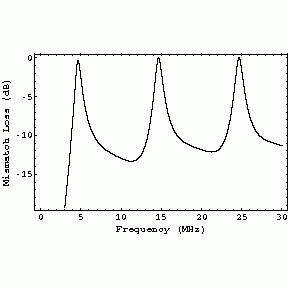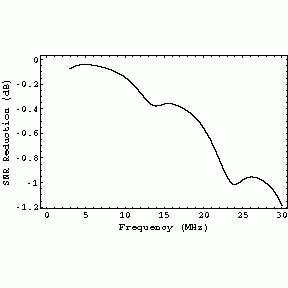Taken from a usenet post by John Doty in 1996
In article <9612182335114148@mogur.com> len.anderson@mogur.com (Len Anderson) writes:
> TV>> I wonder if a longwire balun would help match the impedance & provide a
> TV>> better signal?
> No, it will (primarily) change only the magnitude of the antenna
> impedance over frequency. Some bands will have more sensitivity than
> other bands. The antenna tuner will take care of that.
Actually, a fixed matching transformer can dramatically reduce the wild swings in antenna efficiency that a coax fed wire antenna exhibits. Let us calculate:
The following graphs are based on a 15 meter vertical antenna, fed at ground level, using a conical approximation. The antenna’s characteristic impedance is assumed to be 620 ohms, which is typical for a thin wire. For more on the conical approximation, see Chapter 8 of “Antennas” by John D. Kraus (McGraw-Hill, 1950).
The first graph is for an antenna fed directly from 50 ohm coax. The horizontal axis is the frequency in MHz, the vertical axis is the mismatch loss in dB. The well known “quarter wave” resonances near 5, 15 and 25 MHz are visible as sharp peaks where the mismatch loss closely approaches zero.

The second graph assumes a matching transformer with a 9:1 impedance ratio at the feedpoint, presenting the antenna with a load resistance of 450 ohms. At most frequencies, the mismatch losses are considerably lower for this case. The variation in the mismatch loss is also reduced:

Well, so what? In the absence of interference, the signal to noise ratio is the main determining factor for the audio quality of the signal.
The mismatch loss affects both signals and noise, so if the receiver was noiseless the losses would not affect the signal to noise ratio.
Real receivers, however, are not noiseless: if the loss is too high, receiver noise will become dominant, and overally system sensitivity will suffer.
The following results assume cosmic noise of 29 dB above thermal at 10 MHz, declining with increasing frequency at -23 dB per decade. No man made or atmosperic noise is assumed. I assume a receiver noise figure of 10 dB.
First, here is the signal to noise impact of the mismatch losses for a 50 ohm coax feed without a transformer:

Losses in signal to noise of 3-5 dB are likely to be noticeable. The largest impact is in the quiet bands above 15 MHz.
On the other hand: the loss in signal to noise with a 450 ohm feed is much smaller:

You are unlikely to be able to notice losses in signal to noise in this range.
The results depend on the assumptions. A real longwire isn’t usually vertical: this tends to degrade its performance a bit at the low frequency end, while improving it at high frequencies. This is good, because in the model the signal to noise is declining as the frequency increases: the increase in performance cancels part of this.
No man made or atmospheric noise is included. If they are significant, the precision of the match becomes less critical. Man made noise can be significant at any frequency, but atmospheric noise is more significant at the lower frequencies.
A receiver noise figure of 10 dB is mediocre for a solid state receiver or a tube receiver with a triode RF amplifier. Tube receivers with pentode RF stages may be a bit worse than this, and something like a Hallicrafters “Sky Buddy” (no RF stage, pentagrid converter) might have a noise figure >30 dB. The better (smaller) the noise figure, the less you have to worry about matching. Sky Buddy owners will want to tune their antennas very carefully.
I haven’t included cable losses here. These are not terribly important unless you’re using an ATU at the receiver end. If you are, using a fixed transformer to get the match roughly right at the antenna end will reduce the cable losses, because cable losses increase with increasing SWR.
My own experience concurs with the results of this theoretical analysis (or I wouldn’t be writing about it: I’d be trying to figure out what was wrong!). I have experienced “deaf bands” with coax fed antennas lacking matching transformers, but my transformer-fed antennas work well across the HF spectrum (and even down to longwave). I don’t bother with an ATU.